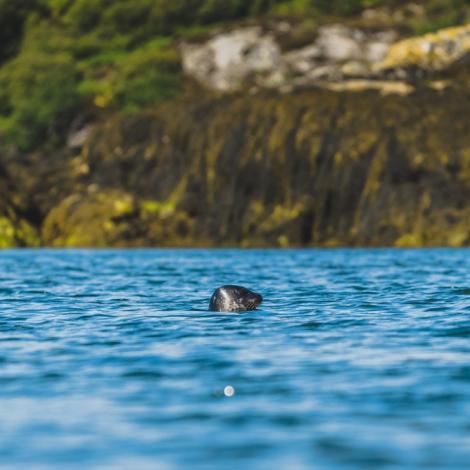Nature - Climate Conversations

Making changes in our lives to protect the environment can have a significant impact on the nature that surrounds us. When you’re out enjoying nature with your friends or family, or chatting with a neighbour over the garden hedge, here’s the information and talking points you need to start a conversation that can help to tackle the twin crises of nature loss and climate change.
Talking points
We need nature and nature needs us.
Protecting and restoring nature is not only important as a solution to climate change, it also has immediate benefits for our health and wellbeing.
By chatting to your friends, family, and colleagues about the ways we can protect nature, you could start a ripple effect of positive action to help keep Scotland the beautiful country we’re proud to call home and, vitally, a place where nature can thrive.
Here are some ideas for you to weave into a conversation.
Talking points for when you’re at home
Can you ‘rewild’ part of your garden? Leaving piles of leaves and twigs and delaying cutting your grass can provide habitat for local animals. Tell your neighbours about what you’re doing, so they take inspiration from you. You could even all take part in ‘No Mow May’, where you avoid mowing for the month of May, to let wildflowers bloom in your lawn, providing a feast for bees, butterflies, and other hungry pollinators.
How can you give nature a home? Try chatting to your family about their ideas for the best places to add native wildflowers, window boxes, birdfeeders, or a source of water. You could visit your local nature reserve to get inspiration for the sort of native plants that would thrive in your garden.
Having conversations at work
Talk to your colleagues and see if you can round up a team for a volunteering project. You could join a local group – or start one – to improve green spaces and paths close to your work. Or you could even travel to some of Scotland’s wildest places to maintain and repair trails and help with projects to enhance habitats for wildlife.
Planting trees is incredible for offsetting carbon emissions, but we need to avoid planting non-native trees, as these can be detrimental to biodiversity and can even reduce the availability of water. If you take part in a tree planting project, be sure to choose a reputable organisation, like Trees For Life.
Find out about volunteering opportunities here.
50%
of Scots wanted to do more to help local wildlife in 2022
Chatting when you’re out and about
Next time you’re walking in nature – or even just through your neighbourhood – stop, listen, and enjoy a mindful minute. Encourage whoever you’re with to do the same. Connect with your surroundings by noticing and talking about what wildlife you can see and hear. Remember to be kind to the nature around you, by not dropping litter and sticking to marked paths.
Did you know trees talk to each other right under our feet? If you’re exploring woodland, or strolling past some urban trees, tell your family or friends about how trees use an underground fungal network nicknamed the ‘Wood Wide Web’ to support their offspring – and sabotage their rivals! You could even take photos of the trees and share them on social media.
Follow along and start your own conversation on our Instagram.
Another great talking point is how diverse native forests and woodlands are essential to the sustainability of the wider landscape. They offer shade for crops and livestock, prevent nutrient loss and soil erosion, improve water quality, reduce the risk of flooding, and support humans’ health and well-being. Woodlands also act like the planet’s hoovers, helping to suck carbon out of the atmosphere. A win for nature and a win for us.
Starting a conversation in your community
Projects like Central Scotland Green Network are creating urban green space to allow people to enjoy the outdoors in their own neighbourhoods – and help nature.
Improving cycling and walking trails provides essential habitat networks for a variety of wildlife. Plus urban spaces with both green (plants and trees) and blue (ponds, lakes, and drainage) infrastructure are resilient, pleasant, and healthy places to be. Combining green and blue is also an effective natural solution to urban and climatic challenges, like air pollution and storm water. Not to mention the positive effect spending time in these spaces can have on our mental health.
Why not start a conversation within your local community about protecting and creating green spaces?
Find out more on the Central Scotland Green Network website.
30%
of global net zero targets could be met with nature-based solutions
Get more ideas for conversations that help to tackle the climate emergency.
Key information
We all need nature to survive – from the air we breathe to the water we drink and the food we eat.
Climate change is already impacting nature in Scotland, with 49% of our national species declining in numbers. In fact, The State of Nature report from 2019 found that 11% of Scottish species were in threat of extinction.
Nature absorbs and stores a lot of carbon. Since human activities will always create some emissions, we can’t achieve net zero without nature absorbing the carbon dioxide we can’t avoid.
49%
of Scottish species declining in numbers
Protect and restore nature
By protecting nature, we can recover what we have lost and store up to 30% of the necessary emissions globally, helping combat climate change.
During lockdown around 80% of the Scottish population enjoyed time outdoors at least once per week, which most people felt the health and wellbeing benefits from. We de-stress, relax, unwind, feel energised and revitalised and our physical health is improved after spending time outdoors.
In Scotland’s more urban areas, street trees have been found to reduce neighbourhood air pollution by 50%.
It’s clear that nature is vital to the planet, but also to each of us as individuals, and we must do more to restore and regenerate it.
50%
Trees in urban areas can reduce air pollution by 50%
Find out what Scotland’s already doing to protect and restore nature.




